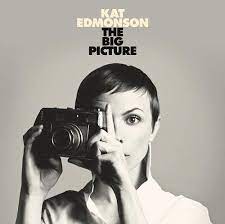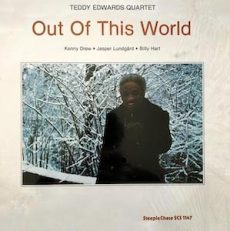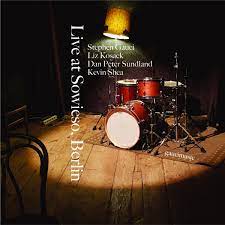
Requisites
Groovin’ ~ Idrees Sulieman, Per Goldschmidt, Horace Parlan, Mads Vinding, Billy Hart | By Eddie Carter
It happened like this; I’d recently been revisiting several SteepleChase albums in my library. One of those titles led me to this morning’s discussion. Groovin’ (SteepleChase Records SCS 1218) is a 1985 straight-ahead-blowing session. It was the third album Idrees Sulieman recorded for the Danish label and was made five days before his sixty-second birthday. I’ve enjoyed the trumpeter’s playing since hearing him on Tenor and Flute, The Cats, and The Hawk Flies High. Here, he’s working with Per Goldschmidt on baritone sax (tracks: A1, A3, B1, B3) and tenor sax (A2, B2), Horace Parlan on piano, Mads Vinding on bass, and Billy Hart on drums. My copy is the original 1986 Danish Stereo album.
Groovin’ High by Dizzy Gillespie starts the first side with the quintet’s collective melody at a relaxing beat. Idrees gets things going with a delightful solo. Per comes next with an effectively carefree reading. Horace’s following statement is as refreshing as a cool drink on a muggy day. Mads delivers an inspired interpretation next; Billy closes with an interesting exchange with the front line into the ending theme. Tell Me What’s Your Name is a pretty tune by Kathe Laursen that begins with a delicate melody by Sulieman, who Goldschmidt joins as it unfolds. The two horns work together to give warmth and tenderness in the song’s only solo, which draws to a conclusion in a gentle climax.
If I Only Knew, the first of two tunes by Idrees Sulieman, closes Side One. Billy’s brief introduction brings the song to life, segueing into the medium melody. Mads goes to work first, then Idrees shows off his gentle side. Horace states his case with graceful lines next; then Per delivers a warm, friendly and intimate finale leading to the theme’s restatement. Lipstick by Kathe Laursen continues the ensemble’s medium groove with a collective melody. Sulieman sets the stage on the first statement, then Parlan offers an equally significant reading. Sulieman shares a few thoughts with Hart in the finale preceding the closing chorus.
The ensemble takes a stroll to The Center of Copenhagen next. Idrees Sulieman’s second original begins with the group’s theme in unison. Idrees and Per provide the spotlight in an entertaining exchange, then Horace delivers a captivating closer ahead of the quintet’s reprise and exit. Per Goldschmidt’s Happy Ending finishes the album on a lively note with the group’s spirited melody. Sulieman takes off first with a lightning-fast interpretation, followed by Goldschmidt, who’s equally quick in the second reading. Hart has a vigorous conversation with the front line ahead of the reprise and the song’s climax.
Nils Winther produced Groovin’, and Ole Hansen was the recording engineer of this digital recording. The album has an excellent soundstage with exceptionally clear fidelity that brings the musicians to your listening room. The record is also incredibly quiet until the music starts. I happily recommend Groovin’ on your next record hunt if you’re in the mood for jazz to help you unwind after a busy day or week. It’s a hidden treasure with a stellar lineup; Idrees Sulieman, Per Goldschmidt, Horace Parlan, Mads Vinding and Billy Hart. Every tune is a pleasure to hear, and it’s a very enjoyable album I’m sure you’ll be glad to have in your library!
~ Tenor and Flute (Riverside RLP 12-240), The Cats (New Jazz NJLP 8217), The Hawk Flies High (Riverside RLP 12-233) – Source: Discogs.com ~ Groovin’ High – Source: JazzStandards.com ~ © 2023 by Edward Thomas Carter
More Posts: choice,classic,collectible,collector,history,instrumental,jazz,music,trumpet

Daily Dose Of Jazz…
Kat Edmonson was born in Houston, Texas on August 3, 1983 and is the only child of a single mother who enjoyed songs from the Great American Songbook and traditional pop from the 1940s and ’50s. She wrote her first song at age nine while riding the school bus. In 2002, after a year at the College of Charleston in South Carolina, she moved to Austin, Texas, to pursue a music career.
The same year Edmonson auditioned for the second season of American Idol and was one of the Top 48 contestants invited to Hollywood in Losa Angeles, California. Returning to Austin from Los Angeles and spent several years as a regular in the Austin club scene. She worked briefly in real estate but quit her day job in 2005 making the decision to pursue music full time.
2009 saw Kat self-release her debut album, Take to the Sky, which reached the Top 20 on the Billboard magazine jazz chart. Her sophomore release Way Down Low in 2012 was the result of a successful Kickstarter campaign. It received a warm critical reception from The New York Times and NPR, reaching No. 1 on the Billboard Heatseekers chart. Her third album, The Big Picture, was released in 2014, which also reached No. 1 on the Billboard Heatseekers chart.
She would go on to open for Lyle Lovett’s tour, perform on The Tonight Show with Jay Leno, on NPR’s Tiny Desk, Austin City Limits and A Prarie Home Companion. By 2013 she had her first U.S. tour and an invitation to play the Montreux Jazz Festival. Opening for Jamie Cullum the same year she toured France, Germany, the Netherlands, Portugal, Spain, and the UK. She went on to tour with Michael Kiwanuka, Chris Isaak, and Gary Clark Jr.
All this led to film appearances in Angels Sing and Café Society, her songs used in Admission, her song Dark Cloud in the opening sequence of Closure, her song If in Netflix’s Russian Doll, and a Cocca~Cola Winter Olympics commercial.
Vocalist Kat Edmopnson continues to stretch the boundaries of her talent with performances and recordings.
More Posts: bandleader,history,instrumental,jazz,music,vocal

Requisites
Listen Here ~ The Gene Harris Quartet | By Eddie Carter
After a long week, I wanted to hear something to help me unwind, so I picked out a wonderful 1989 album, Listen Here (Concord Jazz CJ-385), by The Gene Harris Quartet. I was introduced to pianist Gene Harris as a child when he was a member of The Three Sounds and grew up listening to their Blue Note albums. One of my favorites is Blue Hour, the group’s collaboration with Stanley Turrentine. The trio disbanded in the seventies, and Harris embarked on a successful solo career recording for Blue Note, JAM, and Concord Jazz. On this album, he’s working with Ron Escheté on guitar, Ray Brown on bass, and Jeff Hamilton on drums. My copy is the original U.S. Stereo release.
This Masquerade by Leon Russell opens the album with the quartet’s gentle introduction. Gene brings out the song’s beauty with a light touch during the delicately gorgeous melody and the song’s only solo. The group reconvenes for the closing chorus, and Ron takes the song out in a tender dissolve. Up next is Don’t Be That Way by Benny Goodman, Edgar Sampson, and Mitchell Parish. The foursome’s lively and spirited theme gets things off to a great start. Escheté is up first with a joyously infectious reading. Harris moves through the rhythm section like a musical twister on the following solo ahead of the closing chorus and exit.
The pace slows down for I’ve Got A Feeling I’m Falling by Billy Rose, Harry Link, and Thomas “Fats” Waller. The quartet begins this old favorite with an elegantly tender melody. Gene’s opening solo is a mix of lyrical beauty and nostalgia. Ron has a short statement that’s soft and tender before the leader’s return for the closing chorus. The title song, Listen Here, by Eddie Harris, opens with Brown’s introduction, joined by Escheté and Hamilton into Harris’ feisty melody. The pianist continues grooving on the lead solo, then Eschete cooks on the following statement. Brown wraps it up with a brief reading preceding Gene’s return for the vibrant finale.
Blues For Jezebel is named for Gene’s cat; from the infectious beat of Jeff’s introduction, she must have been quite a pet. The quartet begins with a smooth-flowing melody, then Ron indulges in some fun on the opening solo. Gene follows with a relaxing reading as enjoyable as a favorite pair of shoes into the ensemble’s closing chorus. Sweet and Lovely, by Gus Arnheim, Charles N. Daniels, and Harry Tobias, is an old thirties chestnut that receives a beautiful treatment from the ensemble. Harris starts the gracefully moving introduction and melody. Escheté applies a tender touch to the first solo. The leader follows with a sultry, soulful statement ahead of the closing chorus and slowly dissolves.
Lullabye by Chuck Mangione is not a children’s song. It’s a pretty tune that Gene introduces alone, segueing into an attractive ensemble melody that’ll have your toes tapping along. Gene takes a playful romp in the only interpretation, with the rhythm section complimenting him into a solo fade out by Ron and Ray. Irving Berlin’s The Song Is Ended is taken at a laid-back tempo, beginning with Gene’s introduction into the quartet’s leisurely melody. Escheté is up first with a carefree interpretation, including a brief walk by Brown before it concludes. Gene takes it up a notch with a rousing statement before the ensemble reprises the theme, and the pianist ends softly.
Concord Jazz’s founder, Carl E. Jefferson, produced Listen Here. Phil Edwards and Stuart Hirotsu were the recording engineers, and George Horn was the mastering engineer. The album’s sound quality is stunning, with an excellent soundstage that transports the listener to the studio as the quartet is recording. The pressing is flat and quiet until the music starts. Gene Harris used Ron Escheté whenever he could and always with great results. They recorded nine albums together on Concord Jazz and eleven overall. If you’re a fan of this talented pianist and only know him from The Three Sounds, I invite you to add Listen Here by The Gene Harris Quartet to your record shopping list. It’s a perfect choice to kick back and listen to after a long day or week or when your quiet moments are at a premium!
~ Don’t Be That Way, Sweet and Lovely – Source: JazzStandards.com ~ I’ve Got a Feeling I’m Falling; The Song Is Ended, This Masquerade – Source: Wikipedia.org © 2023 by Edward Thomas Carter
More Posts: choice,classic,collectible,collector,history,instrumental,jazz,music,piano

Requisites
Out Of This World ~ Teddy Edwards Quartet | By Eddie Carter
In this morning’s discussion from the library, the Teddy Edwards Quartet comes to play with their delightful 1981 release, Out of This World (SteepleChase Records SCS 1147). Theodore Marcus Edwards was born in Jackson, Mississippi, and comes from a musical family. His father and grandfather were both musicians, and he began playing the alto sax and clarinet at an early age before taking up the tenor sax. He later recorded and played with many great jazz musicians and has an extensive discography as a leader and sideman. He’s joined on this date by an excellent rhythm section, Kenny Drew on piano, Jesper Lundġard on bass, and Billy Hart on drums. My copy is the original U.S. Stereo pressing.
Side One opens with No Name No. 1, the saxophonist’s first of two original tunes. The ensemble starts with a rollicking groove on the opening chorus; then Teddy takes flight with a bright, boppish interpretation. Kenny comes in with a passionate performance; next, Jesper walks his bass briskly. Billy has a short conversation with Teddy leading to the theme’s restatement and abrupt stop. The pace eases the tempo slower for Edwards’ April Love. It’s a pretty song that the trio introduces before the leader steps up to deliver the beautiful theme and opening statement. Drew comes in next with an attractive interpretation complemented by Lundġard and Hart’s foundation preceding the ending theme and summation.
The title tune, Out of This World, by Harold Arlen and Johnny Mercer, debuted in the 1945 romantic comedy of the same name. The quartet swings the melody at a medium beat. Teddy lifts the opening solo to new heights of virtuosity. Kenny follows with a dazzling display of finger dexterity, then Jesper briefly comments ahead of the closing, and the trio dissolves into silence. Summertime by George Gershwin and DuBose Heyward begins Side Two with Teddy’s introduction, which branches into the foursome’s lovely theme. Edwards tells a wonderful story in two gorgeous readings. In between them, Drew presents a statement of great sensitivity. Lundġard matches them in melodic ideas in the closer before Edwards delivers the reprise, and the foursome disappears softly.
The quartet opens another page of The Great American Songbook with That’s All by Alan Brandt and Bob Haymes. It comes to life with Kenny’s deceptively simple introduction and Teddy’s soothing theme. The saxophonist’s opening statement is rendered with incredible beauty and enchantment. Kenny has a brief moment to present an especially warm solo preceding the leader’s return. Cheek To Cheek by Irving Berlin is from the 1935 film Top Hat and concludes the album on an upbeat note. Hart opens with a brisk introduction, setting the stage for Edwards to take off on a spirited melody and opening statement of zestful virtuosity. Drew has the next spot for an equally lively performance, and Hart ends in an enthusiastic whirlwind before Teddy reappears to wrap it up.
Nils Winther produced Out of This World, and Freddy Hansson was the man behind the dials of the recording. The album has a stunning soundstage, and each instrument is captured perfectly. The highs sparkle, the midrange is clean and crisp, and the bass is solid. The record is also incredibly quiet until the music starts. If you’re in the mood for an excellent Hard-Bop album, I invite you to give Out of This World by The Teddy Edwards Quartet a listen at your earliest opportunity. It’s a great album that offers a glimpse into this underrated but talented musician, and I can’t recommend it enough for a spot in your library!
~ Cheek To Cheek, Summertime, That’s All – Source: JazzStandards.com ~ Out of This World – Source: Wikipedia.org © 2023 by Edward Thomas Carter
More Posts: choice,classic,collectible,collector,history,instrumental,jazz,music,saxophone

Daily Dose Of Jazz…
Dan Peter Sundland was born in Oslo, Norway on July 15, 1986 and grew up in Børsa, a village outside Trondheim, Norway. He started playing bass at age 14 and studied with bass players Andreas Bergsland and Mattis Kleppen. He was a member of Middle-Norwegian Youth Big Band and went on to become a member of the S. Møller big band.
Attending Sund Folk College from 2005 to 2006 he then attained a bachelor’s degree in jazz performance at NTNU Music Institute in Trondheim in 2010. He went on to get his European Jazz Masters degree (EUJAM) at NTNU Music Institute with exchange to Berlin Jazz Institute in 2012 and Rytmisk Musikkonservatorium in Copenhagen, Denmark in 2013.
Active in the jazz and improvisation scenes in Norway and Berlin, Germany he has set himself apart by his expressive, wide ranging playing techniques, including cello-like bowing and a varied palette of percussive colours. Has been featured with musicians including Jim Black, John Hollenbeck, Axel Dörner, Tobias Delius, Hans Hulbækmo, Hanna Paulsberg, Eirik Hegdal, John Pål Inderberg and Tor Haugerud.
His discography includes compositional work for his own eleven-piece Elevenette, the Berlin based improvising quartet Home Stretch and sideman work and collective groups including Lina Allemano’s Ohrenschmaus, Simon Kanzler’s hardcore opera and singer-songwriter Port Almond.
Electric bassist and composer Dan Peter Sundland, who has led Trondheim Improvisation Orchestra together with Peder Simonsen, continues to compose, perform and record.
More Posts: bandleader,bass,composer,history,instrumental,jazz,music




